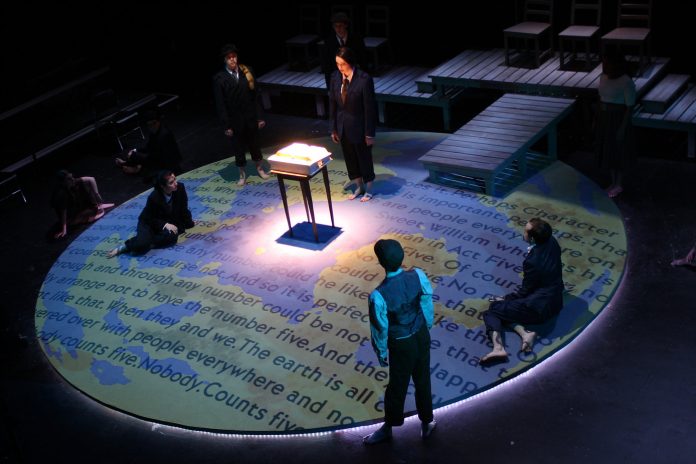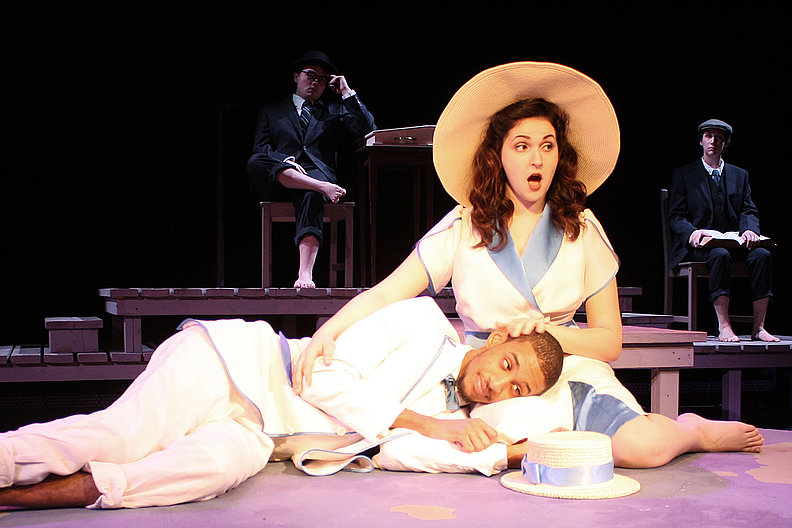
One syllable, infinite meanings: Listen to Me.
What does it mean to mean?
What does it mean to not mean?
Words of so much thought, so much weight, so much to muse on—words of one syllable.
This nebulous navigation of significance, this mind maze full of disconnected words that somehow scrambled over each other to frantically join hands, only to be broken apart at the last second and firmly put back in their place (if such a place ever existed at all, that is) was at the core of Professor Jim Peck’s production of Gertrude Stein’s Listen to Me, a play that explodes the form of all plays and a story that actively seeks not to tell a story. As her biography and background in the Listen to Me program states, Stein was a postwar modernist whose talents branched into many different facets of writing, including poetry, novels, and plays; through each, she attempted to part from tradition. This can be seen even in Listen to Me’s raw script, which Rachel Brudner ’19, who played the Eighth Character, remembers as both a difficult challenge and a ripe opportunity.
“Gertrude Stein did not specify in most places which characters say which lines, so we as a cast had to decide for ourselves not only how we would interpret the text, but who would say what in the script,” Brudner said. “It was challenging and took a long time, but it was so rewarding. We would sit around in a circle for a portion of each rehearsal and discuss our interpretations of each scene, then assign lines, and put it on its feet! We focused a lot on stage pictures and creating images that would evoke emotion. I loved how collaborative Jim [Peck] made this process—that was definitely my favorite part of the creation of this show!”
This painstaking assignment of lines and roles led to an extremely intriguing setup in terms of the show’s established hierarchy. Besides the two named characters, Sweet William and Lillian, there were three ranks of characters, each differently dressed and playing a different role in social order of the piece: the “threes,” the “fours,” and the “sixes” (though the “threes” and “fours” would often group together to make the “sevens”). Jessica Orelus ’19 brought to life the Ninth Character, a member of the “sixes” who was often over- looked by those higher on the social ladder.
“There is the earth and it is dying. There are the six who are hyper aware of it and there are the seven who can afford to not be,” said Orelus. “The seven erase us in the beginning, following a trend Sweet William later gives voice to in the show, that everything that is is one syllable and everything that is not are two. Two syllables or more are complicated, and the seven try to keep themselves as unaware of the complicated as possible, so much so that often it is as if they cannot hear the six at all… [My character] was desperate to be counted and resented when the seven chose not to. The world was dying and though it did not affect the seven (the suited characters) quite so immediately, it certainly was affecting the six in real time.”
Though this was an agreed-upon backdrop for the cast and crew’s interpretation of the show, part of the beauty of this show is that it is so subjective—because there is no story, no implicit meaning to try and grapple with, each audience member’s feelings are valid, a point emphasized by Becca Canziani ’17, who played the Fifth Character in her second and final mainstage production.
“The goal was to create a place in which the audience is stimulated and is aware that they’re having a reaction to what’s going on, but that they might not necessarily know why they’re having that reaction or how they came to feel how they feel,” Canziani said. “One of the most common interpretations that I’ve heard but not thought about myself is that Sweet William and Lillian represented Adam and Eve or some kind of first man and first woman on the earth. I hadn’t thought of that, but I can totally see how that’s there…The thing that the play is most about for me is human interaction and connection. It’s about how we group ourselves and are a part of different groups, and who gets to have a place in what group, and who matters in a certain group. Who gets to decide who matters and who gets their place taken away? Who do we listen to and who do we ignore?”
Who indeed? This manifold collection of meanings, which many audience members attempted to collect in tandem with the cast and crew, only furthers the idea that, despite all of our human differences, the one thing we all strive for is connectedness. Immediately after the show was over, revealing that none of the characters had ever even “met,” I was simply confused: what had I been watching the whole time, if these characters had never known each other? Who were they, and why had they been speaking as different collectives, their tones ranging from comedic to hopeful to just disappointed? What did any of it mean?
Talking to my friends as I exited the theater, I tried to gauge what they thought had occurred—was Sweet William a God-like figure? Was Lillian trying to make or break her relationship with him? Did any of the characters even exist? It was hard to face the fact that none of these questions could be answered, hard to comprehend that the play couldn’t be fit into some kind of pieced-together rhythm or flowing rhyme. If analysis wasn’t the answer, then what was?
“Something that helped us [the actors and those working on the project] a great deal in the beginning of the process was arresting our desire of ‘getting’ it and making peace with the fact that it was more about opening ourselves to the experience of the text rather than trying to understand it.” advised Orelus. “…There is a freedom to be found in suspending the desire or need ‘to get it,’ because there was nothing to be gotten…As Jim Peck, our director, once eloquently wrote or quoted, Gertrude Stein’s Listen to Me is a ‘cerebral frolic,’ and I could not say it any better than that.”
Listen to Me certainly provided an audience experience like no other— a physical manifestation of a mind for an hour and a half, everyone was space in which, so intimately connected, yet so deeply separated by our outside-ness, our lack of certainty about what was going on in front of our eyes. Despite having watched the same story unfold, we as audience members had “not met”—not yet, that is, until we exited the theater and shared our thoughts with each other, melding theories, thoughts, and minds in collective collaboration.
Maybe the future isn’t so lonely after all.
C
U
R
T
A
I
N
Brooke is a senior double majoring in English and Media & Communication. She's passionate about french toast, Kate Bishop, Steven Universe and the ocean coasts of Ireland. On campus, she is a Writing Tutor, Orientation Leader and member of the Girls Next Door, Muhlenberg's all-lady a capella group. She could not be more excited to serve as your Editor-In-Chief this year!























